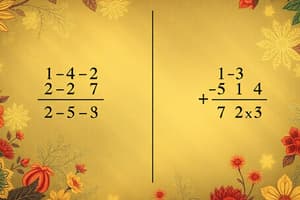Podcast
Questions and Answers
What is the first step in solving a division word problem?
What is the first step in solving a division word problem?
- Think about what it asks
- Carry out the division operation
- Identify the details needed
- Read the problem carefully (correct)
In the example with Priscilla and the cheese, what is the total weight of the cheese she bought?
In the example with Priscilla and the cheese, what is the total weight of the cheese she bought?
- ¼ pound
- 2 pounds
- 1 pound
- ⅔ pound (correct)
What is the portion size that Priscilla wants to make with the cheese?
What is the portion size that Priscilla wants to make with the cheese?
- ⅓ pound
- 1 pound
- ½ pound
- ¼ pound (correct)
What is the first step in dividing fractions?
What is the first step in dividing fractions?
What is the purpose of simplifying the answer when solving a division word problem?
What is the purpose of simplifying the answer when solving a division word problem?
In the example with Priscilla and the cheese, how many portions can she make?
In the example with Priscilla and the cheese, how many portions can she make?
What is the second step in the process of dividing fractions?
What is the second step in the process of dividing fractions?
In the example $\frac{1}{2} / \frac{1}{3}$, what is the result after the first two steps?
In the example $\frac{1}{2} / \frac{1}{3}$, what is the result after the first two steps?
What is the purpose of the 'cross cancel' step in dividing fractions?
What is the purpose of the 'cross cancel' step in dividing fractions?
What is the purpose of the final 'check' step in dividing fractions?
What is the purpose of the final 'check' step in dividing fractions?
What is the simplified result of the example $\frac{1}{2} / \frac{1}{3}$?
What is the simplified result of the example $\frac{1}{2} / \frac{1}{3}$?
Flashcards are hidden until you start studying
Study Notes
Solving Division Word Problems and the Division of Fractions
Division problems involve splitting a quantity evenly among parts. This concept can sometimes seem tricky when dealing with fractions. However, by understanding the process and practicing with examples, you can become proficient in solving these types of problems. In this article, we'll discuss techniques for handling division word problems and dividing fractions.
Divison Word Problems
To solve division word problems, follow these steps:
- Read the problem carefully: Make sure you understand the quantities involved, such as weight or length.
- Think about what it asks: Determine the unknown variable you need to calculate.
- Identify the details needed: Figure out the given values, like the total amount or the number of parts.
- Carry out the division operation: Divide the total amount by the part size to determine the number of parts.
- Simplify: If possible, reduce the answer to its simplest form.
- Check: Ensure the answer makes sense in context.
For instance, if Priscilla buys cheese weighing ⅔ pound and wants to make portions that are each ¼ pound, you would calculate how many portions she can make using dividing fractions:
Total weight / Portion size = Number of portions
⅔ pound / ¼ pound = _______ portions
The result would indicate that Priscilla could make 6 portions.
Dividing Fractions
When dividing fractions, follow these procedures:
- Multiply: Multiply the numerator of the dividend by the denominator of the divisor.
- Invert: Take the reciprocal of both the numerator and denominator of the quotient.
- Cross cancel: Eliminate common factors between the top and bottom.
- Check: See if the resulting equation balances.
Consider the following example:
\(\frac{1}{2}\) / \(\frac{1}{3}\) = ?
First, multiply and invert:
\(\frac{1}{2} * \frac{3}{1} = \frac{1}{2} \times 3 = \frac{3}{2}\)
\(\frac{3}{1} / \frac{1}{2} = \frac{3}{1} \times \frac{2}{1} = \frac{3}{2}\)
Next, cross cancel:
\(\frac{3}{2}\)
Finally, the result checks out:
\(\frac{3}{2}\) is the simplified result.
By utilizing these strategies, you can successfully tackle division word problems and the division of fractions. Remember to practice regularly to improve your skills in solving these types of mathematical challenges.
Studying That Suits You
Use AI to generate personalized quizzes and flashcards to suit your learning preferences.




